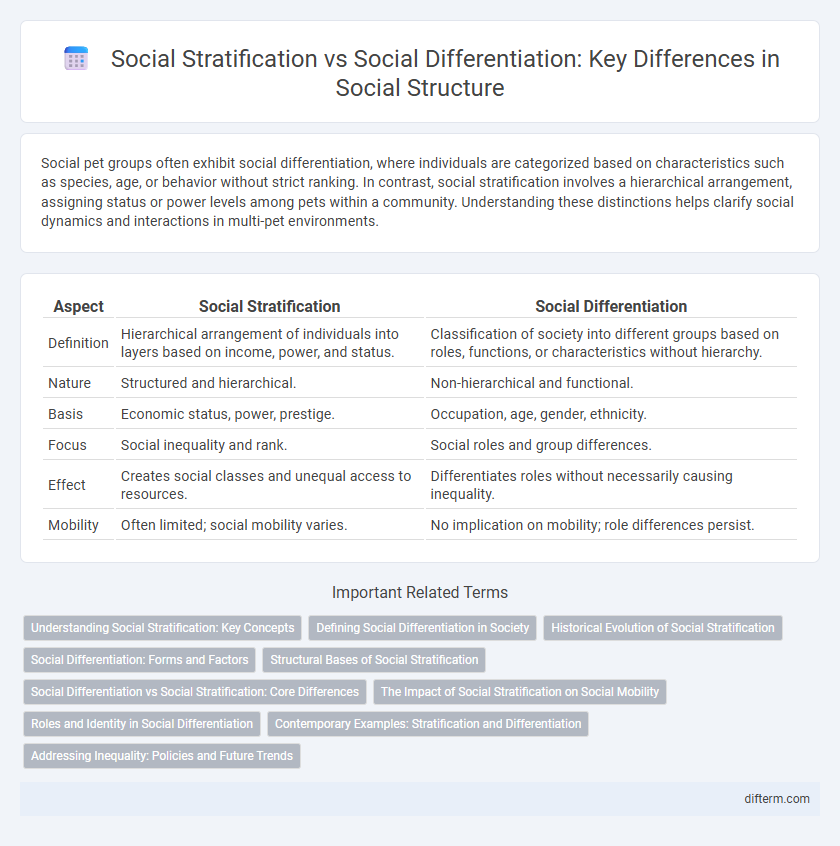Social pet groups often exhibit social differentiation, where individuals are categorized based on characteristics such as species, age, or behavior without strict ranking. In contrast, social stratification involves a hierarchical arrangement, assigning status or power levels among pets within a community. Understanding these distinctions helps clarify social dynamics and interactions in multi-pet environments.
Table of Comparison
| Aspect | Social Stratification | Social Differentiation |
|---|---|---|
| Definition | Hierarchical arrangement of individuals into layers based on income, power, and status. | Classification of society into different groups based on roles, functions, or characteristics without hierarchy. |
| Nature | Structured and hierarchical. | Non-hierarchical and functional. |
| Basis | Economic status, power, prestige. | Occupation, age, gender, ethnicity. |
| Focus | Social inequality and rank. | Social roles and group differences. |
| Effect | Creates social classes and unequal access to resources. | Differentiates roles without necessarily causing inequality. |
| Mobility | Often limited; social mobility varies. | No implication on mobility; role differences persist. |
Understanding Social Stratification: Key Concepts
Social stratification refers to the structured ranking of individuals and groups in a society based on factors such as wealth, power, and prestige, creating hierarchical layers. Social differentiation involves categorizing people into distinct groups based on characteristics like occupation, ethnicity, or gender, without implying hierarchy. Understanding social stratification reveals how systemic inequalities are maintained and reproduced across generations through mechanisms like caste, class, and status systems.
Defining Social Differentiation in Society
Social differentiation refers to the process by which distinct social roles, categories, or groups form within a society based on characteristics such as occupation, ethnicity, or gender without implying hierarchical ranking. Unlike social stratification, which involves structured inequality and ranks groups by social status, social differentiation emphasizes diversity and functional diversity among social units. This concept highlights how societies organize themselves into various segments that perform specific functions or cultural roles.
Historical Evolution of Social Stratification
Social stratification historically evolved as hierarchical structures based on wealth, power, and status, deeply influencing societal organization and resource distribution. Early civilizations like Mesopotamia and Ancient Egypt exemplify rigid stratification through class and caste systems rooted in economic roles and divine authority. This contrasts with social differentiation, which categorizes individuals by roles or characteristics without implying ranking, highlighting its more fluid and functional nature within groups.
Social Differentiation: Forms and Factors
Social differentiation refers to the process by which distinct social roles, statuses, and groups emerge within a society, based on varying characteristics such as occupation, ethnicity, and gender. Key forms of social differentiation include age groups, caste systems, and class divisions, each shaped by cultural norms, economic factors, and institutional structures. Factors influencing social differentiation encompass historical context, access to resources, education levels, and power dynamics that create and maintain social boundaries.
Structural Bases of Social Stratification
Social stratification is a structured system of social layers based on wealth, power, and prestige, while social differentiation refers to the categorization of people based on characteristics such as age, gender, or occupation without inherent rankings. Structural bases of social stratification include economic status, institutionalized power, and social prestige, which create rigid hierarchies affecting individuals' life chances. These bases manifest in class divisions, caste systems, and status groups that systematically influence access to resources and opportunities.
Social Differentiation vs Social Stratification: Core Differences
Social differentiation refers to the process by which society categorizes individuals based on characteristics such as occupation, ethnicity, or age, without implying a hierarchy. Social stratification, in contrast, involves the ranking of individuals or groups into hierarchical layers based on access to resources, power, and prestige, often leading to systemic inequalities. The core difference lies in differentiation's descriptive categorization versus stratification's evaluative and hierarchical structuring of social positions.
The Impact of Social Stratification on Social Mobility
Social stratification creates hierarchical layers within society based on factors such as income, education, and occupation, which significantly restrict social mobility by limiting access to resources and opportunities for lower strata. Social differentiation, while highlighting diversity among groups due to roles and characteristics, does not inherently impose rigid barriers on movement between social positions. The deeply entrenched nature of social stratification perpetuates inequality and hampers upward mobility, reinforcing systemic disparities across generations.
Roles and Identity in Social Differentiation
Social differentiation organizes individuals into distinct roles based on characteristics like age, gender, occupation, and ethnicity, shaping diverse social identities within a community. These roles influence behavior, expectations, and interactions, reinforcing social structure without necessarily implying inequality. Social stratification, by contrast, ranks individuals hierarchically, often linking roles to unequal access to resources and power, thereby affecting identity formation through status and privilege.
Contemporary Examples: Stratification and Differentiation
Contemporary examples of social stratification include income disparity in the United States, where wealth distribution creates distinct social classes influencing access to education and healthcare. Social differentiation is evident in workplace roles, such as the varying responsibilities between managers, technicians, and support staff that exist without hierarchical judgment. The gig economy exemplifies both concepts simultaneously by categorizing workers based on contract types while also creating economic divisions impacting social mobility.
Addressing Inequality: Policies and Future Trends
Addressing inequality requires policies that target both social stratification and social differentiation by promoting equal access to education, healthcare, and economic opportunities. Social stratification, characterized by hierarchical layers based on wealth, power, and status, demands redistributive reforms such as progressive taxation and social welfare programs. Future trends emphasize inclusive policies that reduce discrimination, enhance social mobility, and leverage data-driven approaches to identify and mitigate systemic barriers.
social stratification vs social differentiation Infographic

 difterm.com
difterm.com